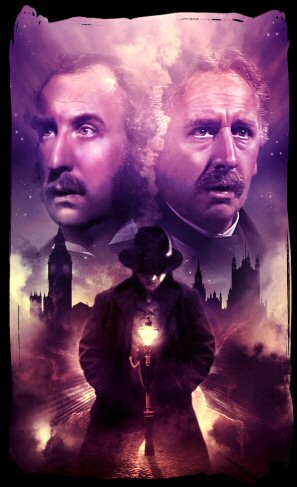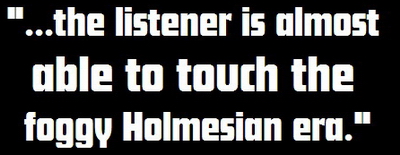|



The Companion Chronicles
have
enabled Big Finish to tell aural
adventures
set
during bygone eras previously consigned to prose. The series’
inspirational format has seen the likes of William Russell, Frazer Hines
and even Katy Manning breathe new life into their celebrated characters,
in brand new adventures grounded in modern sensibilities. Yet the most
memorable Companion Chronicles have been those with the narrowest
view; those that have taken characters teetering on the edge of
companiondom, and given them the sort of treatment that many would say
their television performances warranted. The Mahogany Murderers is
a case in point.
 Living
as we do in days where even one-off Living
as we do in days where even one-off
performers such as Michelle Ryan are officially
classed as “companions”, I don’t think many
fans would begrudge tarring Henry Gordon
Jago and Professor Litefoot with the same
brush. Whilst prior to this release their only
television appearance had been in Robert
Holmes’ Victorian masterpiece, The Talons
of Weng-Chiang, Christopher Benjamin and
Trevor Baxter dazzled in just about every scene
that they were in, often eclipsing Tom Baker’s
Doctor who was, at that point, right at the height
of his powers. The fact that Talons remains to
this day one of the series’ most lauded offerings
speaks volumes about Jago and Litefoot
and
their enduring appeal.
The Mahogany Murderers
is an ideal vehicle
for these two charming characters, Andy Lane’s
script offering both the chance to shine as they
each narrate their half of the action to the other
over a few ales in a suitably evocative alehouse.
The distinct differences in how each narrates
his sections do a splendid job of conveying the
‘chalk and cheese’ dichotomy that makes the
duo so entertaining - the Professor’s sections
are gentle and precise, the key facts interrupted
only by his affably pompous moralising; Jago’s, conversely, are delivered
as a performance, as if he’s competing with his cohort, rather than
bringing him up to speed. The personalities
that Jago gives to the story’s monstrous medley of mahogany marionettes
are every bit as
distinct as his own, if not quite as bombastic. Indeed, no-one could
accuse the out of work theatrical of being wooden...
Moreover, Lane’s dialogue is exquisite - his words are as baroque as those
of Paul Magrs, and almost as macabre too. When fused with the efforts of
stalwart director Lisa Bowerman (who also serves the ales) and sound
designer David Darlington, the listener is almost able to touch the foggy
Holmesian era. It’s always there, threatening to subtly creep into the pub
and drown out the background noise, only to fade away again as our two
protagonists are pulled back into the present with the filling of a
flagon.
Lane’s plot is perfectly attuned to both the period and the characters. A
mysterious Doctor (not that one, though) has been helping prisoners
to escape the dangle by transferring their consciousnesses into wooden
mannequins, and now, under the guidance of wooden crime lord Jack Yeovil,
they want to take over the Empire. Now I find wooden dolls unconscionably
creepy in any event – I found The Magic Mousetrap extremely
unsettling, for instance – but here Lane really sells the idea, with
Jago’s elaborate explanations focusing on their lifeless glass eyes and
their leather tongues. Very nasty. The resolution is unsatisfying,
however, in more ways than one: not only is the murderous’ mannequins
defeat elementary in the most obvious sense, but the mysterious Doctor Tulp remains at large, the larger story frustratingly unsettled.
 Yet
despite the horrors of the Yet
despite the horrors of the
plot, Lane somehow manages
to keep things light. The whole
production is saturated with
in-jokes concerning “dramatic
recitations”, the order of events,
and even the lack of listeners
hanging on the protagonists’
words. For me, the cliffhanger encapsulates the quirky and capricious tone
of the piece better than anything: each narrator delivers his version of
the story’s cliffhanger, Jago first, and then Litefoot. But, rather than
the howl of the closing theme music, the listener hears Jago flatly
concede “you were right. Your climactic moment was better.”
At the end of
the day,
my only real gripe with The Mahogany Murders is a hypothetical one.
The CD says Doctor Who on the cover, yet the titular Time Lord gets
only the most fleeting
of namechecks. This isn’t a Doctor Who story – it’s a Jago &
Litefoot pilot. Had somebody subscribed to the range expecting
“classic
Doctors, brand new adventures” and then found that one of their CDs
featured “investigators of infernal incidents” instead,
then they certainly would have had cause for complaint. Cause, but
not necessarily motive, because Doctor or no,
The Mahogany Murderers
is so sublime a substitute that it’s
arguably even better than the real thing.
|